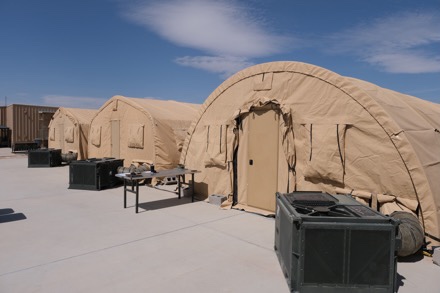CANNON AIR FORCE BASE, N.M. —
One of the most renowned aircraft in the Air Force’s fleet, the CV-22 Osprey tiltrotor aircraft combines the vertical flight qualities of a helicopter with the fuel efficiency and speed of a fixed wing plane. This combination makes it the ideal aircraft for conducting infiltration, exfiltration and resupply missions for special operations forces across long distances.

Now, thanks to pathfinding efforts from the 20th Special Operations Squadron and the 349th Air Refueling Squadron, assigned to the 22nd Air Refueling Wing at McConnell Air Force Base, Kansas, CV-22 aircrews across Air Force Special Operations Command can ensure their aircraft’s extended range by calling on Air Force Mobility Command’s newest tanker.
The 20 SOS & 349 ARS brought a CV-22 and KC-46 Pegasus tanker together for in-air refueling training over Cannon, June 1, 2022. The flight was the first time a KC-46 refueled an AFSOC CV-22.

“This being the first time we operationally refueled with a KC-46, we were able to get some good video for training and development,” said Maj. Anthony Belviso, the CV-22 aircraft commander. “We were also able to get some understanding of what it feels like to fly behind the jet, and work on some different refueling techniques and practices”
One of the new capabilities the KC-46 brings to the table is a hose and drogue system in the same centerline position as it’s refueling boom pipe for fixed-wing aircraft.

“This capability allows the KC-46 to the refuel the Osprey and other drogue compatible receiver aircraft without any modification,” said Maj. Benjamin Chase, the KC-46 aircraft commander. “This is important because it enables flexibility in mission planning and limits the amount of maintenance it takes to prepare for air refueling, especially compared to most aircraft in the legacy tanker fleet.”
The KC-46 is not the only aircraft the CV-22 can receive fuel from while flying. However, its advanced refueling, communications and defensive systems, range and large fuel storage capabilities make it an ideal system for getting CV-22s the fuel they need, even in or near contested environments.

“The CV-22 is specifically designed for long range missions, and when you add on top of that an aerial refueling capability you can extend that distance to the point where you’re only limited by how long the crew is able to fly,” said Belviso. “The KC-46 can get enough fuel to get multiple CV-22s that much further both into and out of combat.”
“The 22 ARW has showcased the capability of the KC-46 to operate out of austere locations in recent exercises,” said Chase. “This is unique among tanker aircraft, and replicates the types of environments the KC-46 to operate out of when refueling the Osprey in real-world missions.”
Another advantage of CV-22s being able to refuel from KC-46s is that it allows for faster refueling during real-world missions.
“Normally, an MC-130J aircraft would have to go up to a tanker to get fuel, then fly to us and give us that fuel, and would have to repeat that process several times,” said Belviso. “Because KC-46s can refuel us directly, we can go straight to them and get everything done much more quickly.”
With the successful training mission, both Chase and Belviso said it would provide the data and real-world experience the Air Force’s KC-46 and CV-22 fleets need to ensure the two airframes could work well together for a long time to come.
“The refueling of the CV-22 marks another success in the program,” said Chase. “It really paves the way for support of the Osprey and other aircraft in the future.”
“I’m glad we were able to get the mission done for the CV-22 community,” said Belviso. “I think this new capability will be tremendous for us going forward, so I’m very happy about that.”
By SSgt Max J. Daigle, 27th Special Operations Wing Public Affairs




























































































































